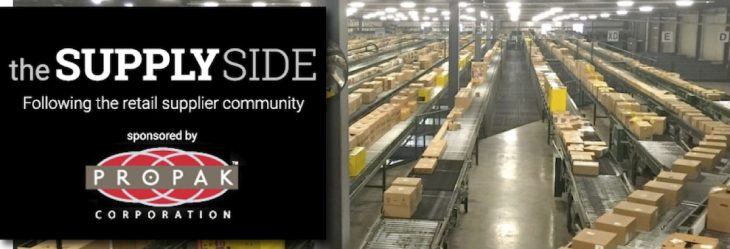The Supply Side: Amazon’s online retail rise plateauing, smaller retailers taking market share
by May 27, 2019 12:29 pm 1,179 views

Amazon has been a major disruptor to traditional retail, but the company’s recent financial results indicate growth by the Seattle-based e-commerce titan is moderating, according to Deborah Weinswig, CEO and founder of CoreSight Research.
It looks as if disruption has come full circle to Amazon.
In a recent investor note, Weinswig said Amazon’s earnings were strong, but online retail sales rose just 12%. She said Prime membership growth has likely plateaued at 45% of U.S. households, as reported by Prosper Insights & Analytics. Also, unit sales by third-party merchants selling on Amazon leveled off at 52%-53% since the first quarter of 2018.
Weinswig said slowing sales growth is behind Amazon’s plan to replace two-day delivery with one-day to its Prime membership perks. She said this is Amazon’s way to support retail market share gains given the lack of growth in Prime memberships and third-party unit sales.
Prime has been a key loyalty driver for Amazon, according to Weinswig, She said the loyalty resulted in the market entry and growth of the beauty, grocery and clothing categories.
“Amazon is the most-shopped apparel retailer in the U.S., based on the number of shoppers,” Weinswig said. “It is also the number one retailer for online grocery purchases and the second most-shopped retailer for purchases of beauty and personal care products.”
She said Walmart and Kroger hold strong positions in online grocery, despite Amazon’s lead in shopper numbers. Walmart plans to add 1,000 new stores for online grocery pickup this year, and market watchers expect that will likely help even the score between Walmart and Amazon for the number of online grocery shoppers. In the beauty and apparel categories other retailers are carving up market share, making it harder for Amazon to hold on to its lead.
SLOWING MOMENTUM
Weinswig said third-party sellers have built out Amazon’s massive online offering. Data marketing firm ScrapeHero reports Amazon.com had a total of 119.93 million products for sale on its site as of April. The largest category is books at 44.2 million. Electronics is the second largest category of products on Amazon with 10.1 million items. The largest categories in terms of products also include home and kitchen (6.6 million), digital music (6 million), arts/crafts (4.9 million), automotive (4 million) and tools/ home improvement (3.7 million).
CoreSight Research and DataWeave report third-party merchants account for 89% of Amazon’s clothing listings and 92.4% of the site’s beauty and personal care sales.
Weinswig said online sales at Amazon are losing momentum. Year-over-year, its first-party sales slowed from 21% in the first quarter of 2016 to 12% as reported in the first quarter of 2019. The report also found growth in third-party sales may have reduced Amazon’s direct product sales. That said, third-party merchants have also experienced slowing in revenue growth. From early 2016 to early 2019 the portion of revenue generated from third-party merchants fell from 46% to 23%, according to CoreSight.
“A slower expansion in sales is natural as Amazon reaches greater scale and maturity,” Weinswig said.
In other words, the law of averages is catching up with Amazon as it did with Walmart years ago. She said the move to one-day delivery suggests Amazon is trying to prop up the slowing momentum.
DIRECT TO CONSUMER
A growing direct-to-consumer channel is also likely to blame for the slowing momentum at Amazon.com and Walmart.com, which also experienced slower growth last year.
A new report from market research firm The NPD Group looked at the impact of direct-to-consumer brands such as Bonobos — which is owned by Walmart — Everlane, Away and Warby Parker that are digitally native retailers taking market share from Amazon and traditional retailers like Walmart.
NPD looked at nine digitally native brands that picked up the largest market share last year. These nine retailers experienced 50% online dollar growth between 2017 and 2018.
“This growth is primarily a factor of new customer acquisition, and nearly half of it stems from apparel-focused sites like Everlane and Bonobos,” said Marshal Cohen, chief retail advisor at NPD.
Cohen reports Everlane and Bonobos top the charts with 22% of dollar share growth last year among digitally native brands. Each company grew its number of customers by an average of 40% and sales increased by 50%. He said it is easier for smaller brands to post high growth numbers, but it’s important to consider their impact on sales by Amazon, Walmart and other online retailers.
“Direct-to-consumer brands’ strong foothold in the apparel industry is directly related to reputation, heritage, and trust, which is particularly important with ‘touch and feel’ products. It’s an uphill battle for online pure-play retailers to compete with the longevity of established DTC apparel brands, especially given that brick-and-mortar assortments are crucial for apparel,” Cohen said.
BRICKS-TO-CLICKS
Despite the proliferation of online apparel sales, Cohen said digital native retailers like Bonobos and Everlane have invested in physical storefronts to help them forge deeper connections with customers. Walmart already has a brick-and-mortar infrastructure of more than 5,400 stores within 10 miles of 90% of the U.S. population.
Just as Walmart has expanded its online grocery pickup, the retailer could also partner with some of the digitally native retailers it has acquired in the past two years to allow pickup of online orders at a Walmart store, according to retail insiders.
Walmart recently said it will continue to add more general merchandise to the online grocery pickup inventory, and while that may never be apparel, it could be seasonal items and accessories.
Don Unser, retail president at NPD, said with assortment it’s imperative digitally native retailers keep assortments fresh with 10% of the merchandise being new at all times. He said retailers with a brick-and-mortar presence can benefit from foot traffic from customers seeking immediate gratification in favor of even one-day delivery as promised by Amazon.
